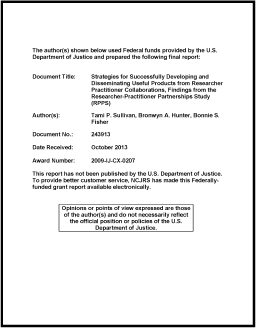
Research has the greatest potential to impact change in practice and policy when (1) it is conducted in collaboration with practitioners rather than conducted by an academic researcher alone, and (2) its findings are meaningfully communicated to the people who influence policy and practice in an easily read and understood format (Block, Engel, Naureckas, & Riordan, 1999; Mouradian, Mechanic, & Williams, 2001). Regarding the communication of findings (i.e., dissemination), government institutions and private foundations that fund research often require a final report that summarizes the study and makes recommendations about how to proceed. These reports are lengthy and typically written in technical language, which makes them less useful to policy makers and administrators in criminal justice (CJ) system state administrative agencies (SAAs), who are those most likely to make and implement change. To increase the likelihood that findings from collaborative research will translate to new or improved practices, services, and policies, it is critical to move beyond the final report as the central product. Instead, plan, before the study begins, for the development and dissemination of more useful products.
